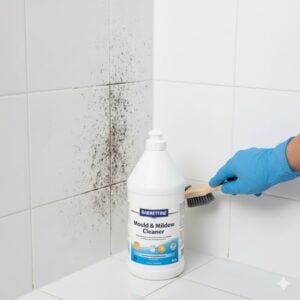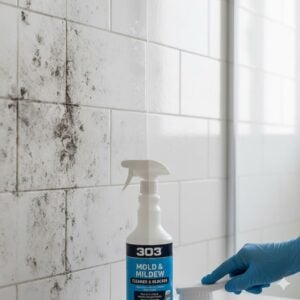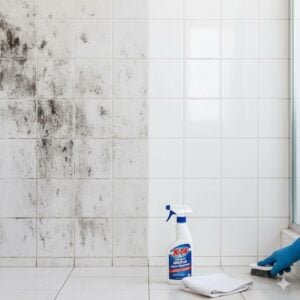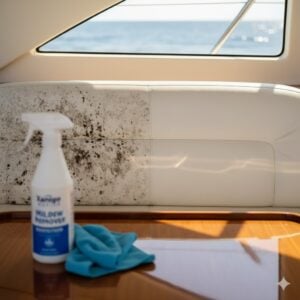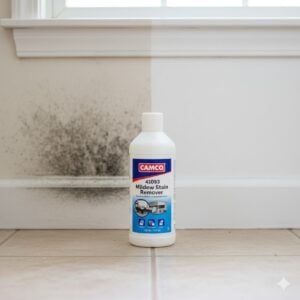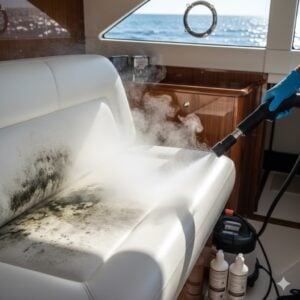Hello and welcome to our latest exploration on maintaining a healthy and safe home environment! Today, we’re diving into the crucial topic of Mold Removal Umm Al Quwain, shedding light on why addressing this issue promptly is not just about aesthetics but integral to your health and well-being. Mold, a common challenge in humid climates, can undermine the structural integrity of your home and pose serious health risks if left unchecked.
We understand the importance of tackling mold effectively and are here to guide you through seven advanced techniques that promise to restore the comfort and safety of your living spaces. Join us on this informative journey to ensure your home remains a sanctuary against the stealthy encroachment of mold.
Table of Contents
Toggle#1 Understanding Mold: Identifying Your Enemy
Mold is a persistent issue that can infiltrate homes in Umm Al Quwain, thriving in moist, warm environments. It’s not just a superficial nuisance; certain types of mold can pose significant health risks and damage the structural integrity of buildings. Understanding the enemy is the first step toward effective mold removal.
Mold comes in various types, but the most common household molds include Cladosporium, Penicillium, Aspergillus, and the notorious Stachybotrys chartarum, often referred to as “black mold”. Each type has its unique characteristics and potential health impacts, ranging from allergic reactions to more severe respiratory issues. Cladosporium, for instance, is known for its potential to cause allergies and asthma, while black mold is notorious for producing mycotoxins that can lead to serious health conditions.
Identifying mold can be straightforward; it typically presents as discolored patches on walls, ceilings, or floors, varying in color from black and green to white and yellow. A musty odor is another telltale sign of mold presence. However, visual signs might not always be apparent, as mold can grow in hidden areas, such as inside walls or under carpets.
The health risks associated with mold exposure should not be underestimated. Symptoms can range from mild allergic reactions like sneezing, coughing, and itchy eyes to more severe health issues, including chronic respiratory problems and immune system suppression. Prolonged exposure can exacerbate existing health conditions and is particularly harmful to individuals with respiratory issues, compromised immune systems, and allergies.
To combat mold effectively, understanding its lifecycle and environmental preferences is crucial. Mold spores are omnipresent, waiting for the right conditions—moisture and warmth—to germinate. This underscores the importance of controlling indoor humidity levels and ensuring proper ventilation to prevent mold growth.
By recognizing the types of mold and their potential health implications, homeowners can take informed steps towards mold prevention and remediation. Addressing mold issues promptly can mitigate health risks and protect the structural integrity of your home, making it a safer environment for everyone.
#2 Initial Steps Before Mold Removal
Before embarking on a mold removal journey, it’s crucial to establish a battle plan that prioritizes your health and safety while setting the stage for effective remediation. This strategy involves a series of preliminary steps designed to prevent the spread of mold spores during the cleanup process and to protect both the residents and the structure of the home.
First, assess the extent of the mold infestation to determine if it’s a job for DIY methods or if professional help is required. For areas larger than ten square feet, or if the HVAC system is contaminated, it’s advisable to consult with professionals. This initial evaluation is critical in tailoring your approach to mold removal.
Next, address the source of moisture that facilitated the mold growth. Without rectifying this fundamental issue, mold will likely recur, rendering any cleanup efforts futile. This may involve repairing leaks, improving ventilation, or using dehumidifiers to reduce indoor humidity levels to below 60%, creating an environment less conducive to mold growth.
Safety precautions are paramount during mold removal. Equip yourself with protective gear including N95 respirators, gloves, and goggles to prevent direct exposure to harmful spores. Sealing off the affected area with plastic sheeting and tape can help contain the mold and prevent its spread to other parts of the home.
Preparing the area involves removing items that are not mold-infested from the vicinity to avoid contamination. Non-porous materials can be cleaned and saved, whereas porous materials soaked by mold may need to be discarded. Ensuring proper ventilation during and after the cleanup process is essential to dissipate mold spores and any volatile organic compounds (VOCs) released by cleaning agents.
Understanding and implementing these initial steps before mold removal can significantly impact the effectiveness and safety of the process. Addressing moisture issues, employing protective measures, and carefully preparing the area lay the groundwork for a successful mold remediation effort, safeguarding your health and home.
#3 DIY Solutions for Minor Mold Problems
For minor mold infestations, a number of DIY solutions can be both effective and economical, making use of everyday household items to combat the mold. Before reaching out for commercial mold removers, consider these less harsh, more environmentally friendly methods that can be just as effective for small-scale mold problems. It’s essential, however, to wear protective gear even when dealing with minor mold removal tasks to avoid exposure to spores.
One popular and widely accessible solution is a mixture of water and white vinegar. Vinegar is a mild acid that can kill most mold species. Simply mix a solution of one part water to one part vinegar and apply it to the moldy areas. Allow the solution to sit for an hour before wiping it off with a damp cloth. This method is particularly effective on hard surfaces like bathroom tiles, kitchen surfaces, and glass.
Another effective solution involves the use of baking soda dissolved in water. Baking soda, a mild, white mineral powder, is a natural disinfectant that also deodorizes, removing the musty smell that mold leaves behind. A solution can be made by dissolving two tablespoons of baking soda into a liter of water, spraying the solution on the mold, then scrubbing it off after a few minutes.
Hydrogen peroxide offers another safe alternative for mold removal. A 3% hydrogen peroxide solution applied directly to the affected area can kill mold on contact. It’s effective on various surfaces, including clothes, walls, and fixtures. Let the hydrogen peroxide sit for 10 minutes before scrubbing the mold away.
For tougher mold stains on grout or in the bathroom, creating a paste with baking soda and a small amount of water can be particularly effective. Apply the paste to the mold, let it sit for a few minutes, then scrub with a brush. This method requires a bit more elbow grease but is highly effective for persistent mold.
It’s important to note that while these DIY solutions are effective for minor mold issues, they may not be suitable for extensive infestations or for molds that produce harmful toxins. In such cases, consulting with a professional mold remediation service is advisable. Using these simple, safe, and natural methods can help keep your home mold-free without the need for harsh chemicals.
#4 Professional Mold Remediation Techniques
When tackling extensive mold infestations or dealing with molds that pose significant health risks, professional mold remediation techniques become indispensable. These advanced methods go beyond surface treatment, addressing the root causes and ensuring a comprehensive cleanup. Professional mold remediation involves a multi-step process, leveraging specialized equipment and techniques to safely and effectively remove mold and prevent its recurrence.
Initially, professionals conduct a thorough inspection to assess the extent of the mold problem and identify the moisture source that enabled mold growth. This assessment is crucial for developing an effective remediation plan. They might use infrared cameras to detect moisture behind walls and other surfaces without the need for invasive measures.
Containment is the next critical step, where the affected area is sealed off using plastic sheeting and negative air pressure. This containment prevents the spread of mold spores to other parts of the building during the removal process. Air filtration devices, including HEPA filters, are then employed to capture airborne spores and purify the air.
The actual mold removal process varies depending on the surfaces involved. Non-porous materials can often be cleaned and salvaged, while porous materials like drywall, insulation, and carpeting may need to be removed and replaced. Advanced cleaning techniques, such as soda blasting, use sodium bicarbonate particles blasted at high pressure to clean mold off hard surfaces, offering an effective and less abrasive alternative to traditional methods.
After mold removal, drying the area thoroughly is imperative to prevent mold recurrence. Professional-grade dehumidifiers and air movers are used to remove moisture, ensuring the area is dry. Finally, the remediation process includes repairing or replacing materials and structures damaged by mold or the removal process itself.
This comprehensive approach, combining specialized equipment and techniques, is what sets professional mold remediation apart from DIY methods. It not only addresses the visible mold but also tackles hidden mold, treats contaminated materials, and takes measures to prevent future growth, ensuring a safe and healthy environment.
#5 Mold Prevention Strategies
Mold prevention strategies are crucial for maintaining a healthy living environment, particularly in areas prone to moisture. Effective mold prevention goes beyond surface-level solutions, involving a comprehensive approach to manage indoor humidity, ensure proper ventilation, and promptly address water leaks or spills. By adopting these strategies, homeowners can significantly reduce the risk of mold growth and its associated health hazards.
Maintaining indoor humidity levels between 30% and 50% is essential for preventing mold growth. This can be achieved through the use of dehumidifiers and air conditioners, especially in humid climates or during wet seasons. Regularly monitoring humidity levels with a hygrometer can help homeowners maintain an environment that is not conducive to mold growth.
Proper ventilation is key to preventing mold in moisture-prone areas such as bathrooms, kitchens, and laundry rooms. Installing and using exhaust fans can effectively remove moisture from these areas. Opening windows to allow for cross-ventilation can also help reduce humidity levels indoors.
Promptly addressing water leaks and spills is critical in mold prevention. Homeowners should regularly inspect plumbing, roofs, and windows for signs of leaks and repair them without delay. Any spills on carpets or upholstery should be dried within 24 to 48 hours to prevent mold growth.
Using mold-resistant products can further safeguard homes against mold. For new constructions or renovations, opting for mold-resistant drywall or paint can provide long-term protection in high-moisture areas.
Regular cleaning and dusting can also prevent mold spores from settling and proliferating. Paying special attention to bathrooms and kitchens, using mold-killing products, and keeping these areas dry and well-ventilated can go a long way in mold prevention.
Ensuring proper drainage around the building foundation can prevent water from seeping into basements or crawl spaces. Sloping the ground away from the foundation and installing gutter systems can effectively direct water away from the building.
By implementing these mold prevention strategies, homeowners can create a healthier, mold-free living environment. These measures not only protect the structural integrity of homes but also safeguard the health of their occupants, making mold prevention an integral part of home maintenance.
#6 The Role of Technology in Mold Detection and Removal
The integration of technology in mold detection and removal has revolutionized the way we approach mold remediation, making the process more effective, efficient, and less intrusive. Advanced technological tools and methods are now employed to identify, assess, and eradicate mold, even in the most challenging environments.
One of the most significant advancements in this field is the use of infrared (IR) thermography. IR cameras enable professionals to detect moisture behind walls, under floors, or in ceilings without the need for demolition or intrusive probing. These cameras work by identifying temperature differences on surfaces, indicating potential moisture issues that are conducive to mold growth. This technology allows for early detection of mold, often before it becomes visible or poses health risks.
Moisture meters have also become an invaluable tool in mold remediation. Available in both pin-type and pinless models, these devices measure the moisture content of materials, helping to pinpoint areas at risk for mold growth. By accurately assessing moisture levels, remediation efforts can be more targeted, preventing unnecessary work and minimizing damage to property.
Air sampling and mold testing technologies have seen significant improvements, offering more precise identification of mold species present in an environment. These tests can determine the concentration of mold spores in the air, which is crucial for assessing the severity of an infestation and verifying the cleanliness of the air post-remediation.
Biotechnology has introduced enzymes and other biological agents that break down mold at the molecular level, offering a more natural and environmentally friendly approach to mold remediation. These innovative treatments can effectively eliminate mold without the use of harsh chemicals, reducing health risks associated with traditional mold removal methods.
Robotic technology and drones are beginning to make their way into mold inspection and remediation, allowing access to hard-to-reach areas such as tight crawl spaces, high ceilings, and complex ductwork. These robots can carry cameras, sensors, and even tools for mold treatment, providing a comprehensive view of mold issues and delivering targeted remediation efforts with minimal human intervention.
The evolution of technology in mold detection and removal has not only enhanced the efficiency and effectiveness of remediation but has also significantly improved safety for both professionals and homeowners. With these advancements, tackling mold problems has become a more precise, less invasive, and more environmentally friendly process.
#7 When to Call the Experts: Recognizing the Signs
Recognizing when to call in the experts for mold removal is a critical decision that can prevent minor mold issues from escalating into major infestations, safeguarding your health and your home’s structural integrity. While DIY methods are effective for small-scale mold problems, certain situations demand the expertise, equipment, and safety protocols that only professional mold remediation services can provide. Here are key indicators that it’s time to seek professional help:
- Extensive Mold Growth: If mold covers an area larger than about ten square feet, or if you’re dealing with multiple affected areas throughout your home, it’s a clear sign that the infestation is beyond the scope of DIY remedies. Professional remediation ensures the complete removal of widespread mold, addressing hidden growth and airborne spores.
- Mold in HVAC Systems: Mold spores in heating, ventilation, and air conditioning systems can quickly spread throughout your home, posing a significant health risk. Professional cleaners have the specific tools and techniques required to thoroughly clean HVAC systems and prevent spores from circulating.
- Mold Resulting from Water Damage: If your home has suffered extensive water damage, especially from contaminated sources such as sewage backups or floodwaters, it’s crucial to have professionals conduct the cleanup. They are trained to handle potentially hazardous materials and can ensure that mold and other contaminants are fully eradicated.
- Health Symptoms: If occupants of your home are experiencing persistent health symptoms such as coughing, sneezing, skin irritation, or respiratory issues that seem to worsen at home, it may indicate a serious mold problem. Professional mold removal can identify and remove the source of the problem, improving indoor air quality and health outcomes.
- Hidden Mold: Sometimes, mold grows in places where it’s not easily visible, like inside walls, under floors, or in attics and basements. Professionals use advanced detection equipment to uncover these hidden infestations, ensuring that no mold is left behind.
Calling in professionals at the right time can save you time, money, and health issues in the long run. They bring experience, advanced technology, and specialized techniques to the table, ensuring that your home is thoroughly cleared of mold and that preventive measures are put in place to avoid future problems. Recognizing these signs and acting promptly can make all the difference in maintaining a healthy, mold-free home.
Why Bio On is Your Go-To Solution for Mold Removal Umm Al Quwain
Bio On stands out as the go-to solution for mold challenges due to its comprehensive approach to mold remediation. With a team of seasoned experts equipped with the latest in mold detection and removal technology, Bio On ensures a thorough and efficient resolution to mold issues. Understanding the unique climate and environmental factors in Umm Al Quwain, Bio On tailors its services to not only address existing mold but also to implement preventative strategies to safeguard against future growth.
The emphasis on customer education and the use of environmentally friendly methods further establishes Bio On as a leader in mold remediation, offering peace of mind and a healthier living environment for all clients. Plus, the availability of 24/7 free consultations makes it easy for individuals to start their journey toward a mold-free home.
Conclusion
In conclusion, tackling mold effectively requires a blend of knowledge, precision, and proactive measures. From identifying the types and potential health risks of mold to employing both simple DIY solutions and advanced professional remediation techniques, understanding mold’s intricacies is key to maintaining a healthy living environment. Bio On offers specialized expertise in combating mold challenges, leveraging state-of-the-art technology and sustainable practices tailored to the unique needs of homes in Umm Al Quwain.
For those facing mold issues or seeking to prevent future infestations, Bio On provides a reliable pathway to a safe and clean home. Don’t hesitate to reach out through the WhatsApp button for a free consultation with Bio On’s expert team, ensuring peace of mind and a mold-free environment.







